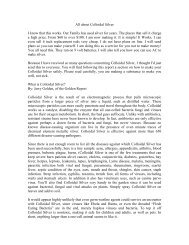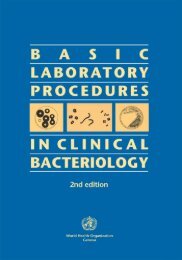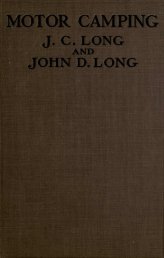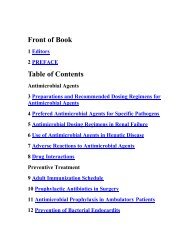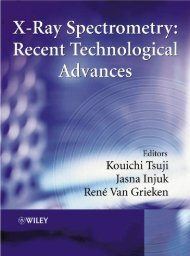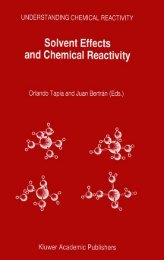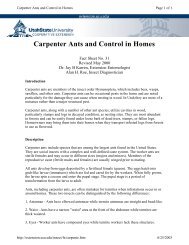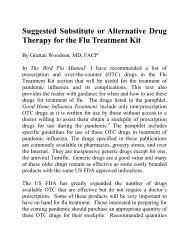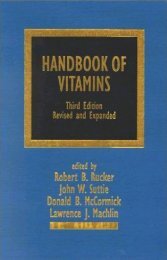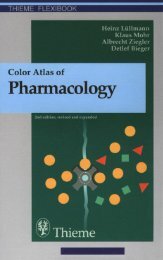The Nutritional Biochemistry of Chromium(III) - Survival-training.info
The Nutritional Biochemistry of Chromium(III) - Survival-training.info
The Nutritional Biochemistry of Chromium(III) - Survival-training.info
Create successful ePaper yourself
Turn your PDF publications into a flip-book with our unique Google optimized e-Paper software.
Use <strong>of</strong> chromium as an animal feed supplement 91In summary, in spite <strong>of</strong> a few positive observations, there do not appear to be anygeneralized improvements in immunocompetence in young pigs with the supplementation<strong>of</strong> Cr, even though this is a period <strong>of</strong> time when the immune system <strong>of</strong> the pigis compromised. Further, while there are two studies that report improved growth andimproved nutrient digestibility with supplementation <strong>of</strong> 200 ppb Cr from CrPic [29, 30],there does not appear to be any generalized improvement in growth performance duringthis period with Cr supplementation. It should be noted that young pigs such as used inthese studies would have been only 5–20 kg BW (compared to a mature body size <strong>of</strong>150–250 kg BW) and would not have experienced very much <strong>of</strong> the normal dilution <strong>of</strong>body Cr that occurs with age (as presented earlier) and thus may not be in particularneed <strong>of</strong> the nutrient.<strong>Chromium</strong> for growing pigsFollowing the nursery phase, pigs are generally moved into another building inwhich they are fed until they reach market weight. In the early part <strong>of</strong> the twentiethcentury, pigs were extremely fat because the fat had commercial value as it was usedto make nitroglycerin which had military uses [31]. Following World War II, this needfor fat ceased, and a consuming public was more interested in a leaner product. Thusthroughout the 1960s, 1970s, and 1980s, there was an intensive effort to change thebody type <strong>of</strong> the pig to be more lean through genetic selection and through dietarymodifications that would result in more lean (muscle) deposition and less fat deposition.In the current marketing structure, producers are rewarded for pigs with higher amounts<strong>of</strong> muscle and are discounted for pigs with high fat content. <strong>The</strong> interest in Cr supplementationduring this period in the life <strong>of</strong> the pig is primarily for its potential impact onmuscling, and secondarily for any potential improvement in feed efficiency (if a pig cangain the same amount <strong>of</strong> weight on less feed, there is an obvious reduction in cost for theproduction <strong>of</strong> that pig). Muscling in pigs is generally measured by the cross-sectionalarea <strong>of</strong> the longissimus muscle (a large muscle that lays perpendicular to the backboneand is processed into the “pork chop”), the fat depth at the 10th rib (this would equateto the amount <strong>of</strong> fat on the outside <strong>of</strong> the pork chop), or by the overall lean percentagein the carcass which is computed from the weight <strong>of</strong> the pig, the longissimus musclearea (LMA), and the 10th rib fat depth (TRF).Great enthusiasm for the potential <strong>of</strong> Cr to improve muscling was generated bythe initial reports <strong>of</strong> a series <strong>of</strong> trials with CrPic from the laboratory at Louisiana StateUniversity (LSU) [32]. Researchers reported increased LMA and decreased TRF <strong>of</strong>carcasses at market when Cr was fed to the growing pigs. In some <strong>of</strong> the trials the LMAincreased more than 20% and the TRF decreased more than 25%. Interestingly, in thethree trials reported, the magnitude <strong>of</strong> increase in LMA and decrease in TRF was greateras the starting weight <strong>of</strong> the pigs on test decreased from 37.8 kg in Trial 1 to 22.4 kg inTrial 3. This effect is not surprising because any benefit that Cr might have on carcassmeasurements would be cumulative, so that number <strong>of</strong> days <strong>of</strong> supplementation should berelated to the desired response. <strong>The</strong>se researchers also established that supplementation<strong>of</strong> Cr as chromium chloride or <strong>of</strong> picolinic acid in the same quantity as that suppliedwhen 200 ppb Cr was supplied as the specific compound CrPic did not elicit any positivemuscling effects. <strong>The</strong> lack <strong>of</strong> effect <strong>of</strong> Cr as chromium chloride was consistent withprevious evaluations [33]. Studies at Virginia Polytechnic Institute and State University



